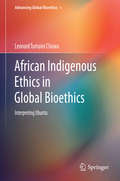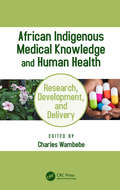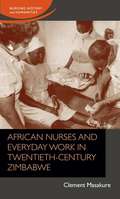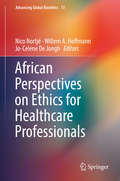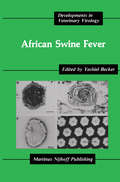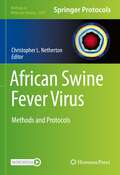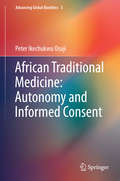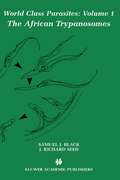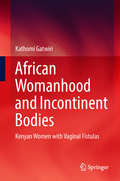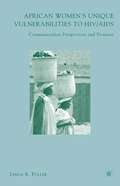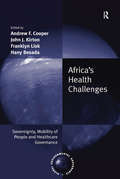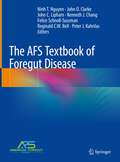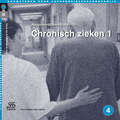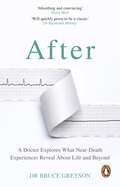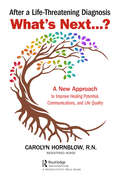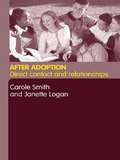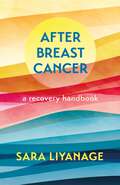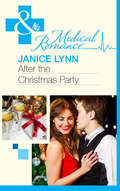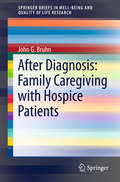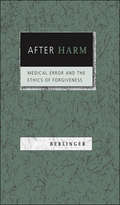- Table View
- List View
African Indigenous Ethics in Global Bioethics: Interpreting Ubuntu (Advancing Global Bioethics #1)
by Leonard Tumaini ChuwaThis book educates whilst also challenging the contemporary schools of thought within philosophical and religious ethics. In addition, it underlines the fact that the substance of ethics in general and bioethics/healthcare ethics specifically, is much more expansive and inclusive than is usually thought. Bioethics is a relatively new academic discipline. However, ethics has existed informally since before the time of Hippocrates. The indigenous culture of African peoples has an ethical worldview which predates the western discourse. This indigenous ethical worldview has been orally transmitted over centuries. The earliest known written African text containing some concepts and content of ethics is the “Declaration of Innocence” written in 1500 B.C., found in an Egyptian text. Ubuntu is an example of African culture that presents an ethical worldview. This work interprets the culture of Ubuntu to explain the contribution of a representative indigenous African ethics to global bioethics. Many modern scholars have written about the meaning of Ubuntu for African societies over centuries. Some scholars have viewed Ubuntu as the greatest contribution of African cultures to other world cultures. None of the scholars, however has explored the culture of Ubuntu as providing a representative indigenous ethics that can contribute to global bioethics as discussed in this book.
African Indigenous Medical Knowledge and Human Health
by Charles WambebeDespite the relevance of and empirical evidence for African Traditional Medicine, based on African Indigenous Medical Knowledge (AIMK), research and development of new phytomedicines from this continent has been slow. African Indigenous Medical Knowledge and Human Health aims to provide a catalyst for health innovations based on the rich African biodiversity and AIMK. The book documents some of the success stories from the continent related to AIMK and serves as a one-step reference for all professionals interested in the research and development of medical interventions - including pharmacognosists, ethnobiologists, botanists, phytochemists, pharmacologists and medical scientists.
African Indigenous Medical Knowledge and Human Health
by Charles WambebeDespite the relevance of and empirical evidence for African Traditional Medicine, based on African Indigenous Medical Knowledge (AIMK), research and development of new phytomedicines from this continent has been slow. African Indigenous Medical Knowledge and Human Health aims to provide a catalyst for health innovations based on the rich African biodiversity and AIMK. The book documents some of the success stories from the continent related to AIMK and serves as a one-step reference for all professionals interested in the research and development of medical interventions - including pharmacognosists, ethnobiologists, botanists, phytochemists, pharmacologists and medical scientists.
African nurses and everyday work in twentieth-century Zimbabwe (Nursing History and Humanities)
by Clement MasakureInformed by the memories of African nurses, this book highlights the experiences of men and women who provided nursing services in Zimbabwe’s hospitals in the twentieth–century. It argues that in their subordinate positions, and within their various capacities – nursing assistants, nursing orderlies, medics and qualified nurses - African women and men played a pivotal role in the provision of healthcare services to their fellow Africans. They transformed hospital spaces into their own, reshaped and reformulated indigenous as well as western nursing and biomedical practices. Through their work, African nurses contributed to the development of the nation by being at the bedside, healing the sick and nursing the infirm.
African nurses and everyday work in twentieth-century Zimbabwe (Nursing History and Humanities)
by Clement MasakureInformed by the memories of African nurses, this book highlights the experiences of men and women who provided nursing services in Zimbabwe’s hospitals in the twentieth–century. It argues that in their subordinate positions, and within their various capacities – nursing assistants, nursing orderlies, medics and qualified nurses - African women and men played a pivotal role in the provision of healthcare services to their fellow Africans. They transformed hospital spaces into their own, reshaped and reformulated indigenous as well as western nursing and biomedical practices. Through their work, African nurses contributed to the development of the nation by being at the bedside, healing the sick and nursing the infirm.
African Perspectives on Ethics for Healthcare Professionals (Advancing Global Bioethics Ser. #13)
by Nico Nortjé Willem A. Hoffmann Jo-Celene De JonghThis book focuses on ethical issues faced by a variety of healthcare practitioners across the Anglophone African continent. This important resource contains in-depth discussions of the most salient current ethical issues by experts in various healthcare fields. Each profession is described from both an African and a South African perspective, and thus contributes to dialogue and critical thinking around African ethics and decision-making. In this way the book provides readers with an understanding of the ethical issues at hand in various professions, including the practical implications of the ethical issues and how to address those effectively. This is a beneficial resource for all those involved in the various healthcare professions addressed in this book, including undergraduate students, lecturers, researchers and practitioners across the continent. Simply put, with the dynamic changes and challenges in healthcare across the globe and in Africa, this is an indispensable resource for healthcare practitioners.
African Swine Fever (Developments in Veterinary Virology #3)
by Yechiel BeckerAfrican swine fever (ASF) is caused by a virus that is classified as a member of the Iridovirinae family. The disease in the warthog, the natural host, in Africa was described in 1921 by R. E. Montgomery. The reservoir of the vi rus is inti cks. The i ntroduct i on of domestic pi gs into territory occupied by warthogs i nf ected wi th ASF in the 1960's has endangered the pig industry around the world. The domestic pig is highly sensitive to ASF and develops a devastating disease that kills the pig without giving the immune system a chance to defend the animal against the virus infection. The ability of ASF virus to infect and destroy cells of the reticuloendothelial system leaves a defenseless host that succumbs to an infection which may be described as an acquired immune deficiency di sease of domestic pi gs. Introduction of the virus into Iberia in the 1960's led to a series of ASF epidemics in Spain and Portugal . . and later in France, that caused heavy economic losses. Between 1976 and 1960, ASF virus made its appearance in Malta and Sardinia . . as well as in Brazil, The Dominican Republic . . Haiti, and later in Cuba. In 1985-6 . . ASF appeared in Belgium and The Netherlands.
African Swine Fever Virus: Methods and Protocols (Methods in Molecular Biology #2503)
by Christopher L. NethertonThis volume provides a compilation of methods that will aid researchers studying virology, immunology, and vaccinology of this devastating disease of swine. Written in the format of the highly successful Methods in Molecular Biology series, each chapter includes an introduction to the topic, lists necessary materials and reagents, includes tips on troubleshooting and known pitfalls, and step-by-step, readily reproducible protocols. Authoritative and cutting-edge, African Swine Fever Virus: Methods and Protocols aims to be a foundation for future studies and to be a source of inspiration for new investigations in the field.
African Traditional Medicine: Autonomy And Informed Consent (Advancing Global Bioethics #3)
by Peter Ikechukwu OsujiThis book focuses on informed consent in African Traditional Medicine (ATM). ATM forms a large portion of the healthcare systems in Africa. WHO statistics show that as much as 80% of the population in Africa uses traditional medicine for primary health care. With such a large constituency, it follows that ATM and its practices should receive more attention in bioethics. By comparing the ethics of care approach with the ATM approach to Relational Autonomy In Consent (RAIC), the authors argue that the ATM focus on consent based on consensus constitutes a legitimate informed consent. This book is distinctive insofar as it employs the ethics of care as a hermeneutic to interpret ATM. The analysis examines the ethics of care movement in Western bioethics to explore its relational approach to informed consent. Additionally, this is the first known study that discusses healthcare ethics committees in ATM.
The African Trypanosomes (World Class Parasites #1)
by Samuel J. Black J. Richard SeedAfrican trypanosomes are tsetse-transmitted protozoa that inhabit the extracellular compartment of host blood. They cause fatal sleeping sickness in people, and Nagana, a wasting and generally fatal disease, in cattle. While trypanosomes are most common to Africa (about 30% of Africa's cattle graze on the fringe of the tsetse habitat), some species have spread beyond its boarders to Asia, the Middle East and South America. The African Trypanosomes, volume one of World Class Parasites, is written for researchers, students and scholars who enjoy reading research that has a major impact on human health, or agricultural productivity, and against which we have no satisfactory defense. It is intended to supplement more formal texts that cover taxonomy, life cycles, morphology, vector distribution, symptoms and treatment. It integrates vector, pathogen and host biology and celebrates the diversity of approach that comprises modern parasitological research.
African Womanhood and Incontinent Bodies: Kenyan Women with Vaginal Fistulas
by Kathomi GatwiriThis book reveals the structures of poverty, power, patriarchy and imperialistic health policies that underpin what the World Health Organization calls the “hidden disease” of vaginal fistulas in Africa. By employing critical feminist and post-colonial perspectives, it shows how “leaking black female bodies” are constructed, ranked, stratified and marginalised in global maternal health care, and explains why women in Africa are at risk of developing vaginal fistulas and then having adequate treatment delayed or denied. Drawing on face-to-face, in-depth interviews with 30 Kenyan women, it paints a rare social portrait of the heartbreaking challenges for Kenyan women living with this most profound gender-related health issue – an experience of shame, taboo and abjection with severe implications for women’s wellbeing, health and sexuality. In absolutely groundbreaking depth, this book shows why research on vaginal fistulas must incorporate feminist understandings of bodily experience to inform future practices and knowledge.
African Women's Unique Vulnerabilities to HIV/AIDS: Communication Perspectives and Promises
by L. FullerThis is an in-depth look at the biomedical, socio-cultural, economic, legal and political, and educational vulnerabilities faced by the population that is most vulnerable to the risk of contracting HIV/AIDS: African women.
Africa's Health Challenges: Sovereignty, Mobility of People and Healthcare Governance (Global Environmental Governance)
by Andrew F. Cooper John J. Kirton Franklyn Lisk Hany BesadaThis volume addresses the ideational and policy-oriented challenges of Africa’s health governance due to voluntary and involuntary cross-border migration of people and diseases in a growing 'mobile Africa'. The collected set of specialized contributions in this volume examines how national and regional policy innovation can address the competing conception of sovereignty in dealing with Africa’s emerging healthcare problems in a fast-paced, interconnect world.
Africa's Health Challenges: Sovereignty, Mobility of People and Healthcare Governance (Global Environmental Governance)
by Andrew F. Cooper John J. Kirton Franklyn Lisk Hany BesadaThis volume addresses the ideational and policy-oriented challenges of Africa’s health governance due to voluntary and involuntary cross-border migration of people and diseases in a growing 'mobile Africa'. The collected set of specialized contributions in this volume examines how national and regional policy innovation can address the competing conception of sovereignty in dealing with Africa’s emerging healthcare problems in a fast-paced, interconnect world.
The AFS Textbook of Foregut Disease
by Ninh T. Nguyen John O. Clarke John C. Lipham Kenneth J. Chang Felice Schnoll-Sussman Reginald C. W. Bell Peter J. KahrilasThe AFS Textbook of Foregut Disease serves as a comprehensive guide of information covering the fast-evolving field of foregut disease. This textbook is designed as a partnership between gastroenterologists & gastrointestinal surgeons with an understanding that an essential component of moving forward in this field is through collaboration. This AFS textbook has been developed by the American Foregut Society, a premier society for foregut disease and all chapters are written by experts in the field. Readership is intended for gastroenterologists, GI and thoracic surgeons, gastroenterology and general surgery residents and fellows, medical students, and integrated health members that manage foregut disease. All chapters follow an organized format that contains many graphs, tables, intraoperative photographs, and illustrations of techniques. This textbook provides the most up-to-date scientific information and will be the definitive resource to guide both the diagnosis and management of foregut disease for years to come.
Afstudeerdifferentiatie 415 Chronisch zieken 1: Niveau 4
by J.M.F. van der Sluis-Houtkamp De Jong Consulting B.V. J.A.M. KerstensDifferentiatiekatern voor BOL- en BBL studenten die in de laatste fase zijn gekomen van de opleiding tot verpleegkundige niveau 4. Het katern is een hulpmiddel bij het afstuderen en reikt verschillende mogelijkheden voor binnen- en buitenschoolse verdieping aan. In de casuïstiek in dit katern komen de eindtermen van deelkwalificatie 415 meerdere malen op verschillende wijze aan bod. Gedurende de BPV toont de deelnemer dat hij/zij in staat is als verpleegkundige zorg te verlenen aan chronisch zieken (415.03). Het kunnen toepassen van GVO (415.04) wordt eveneens in de BPV getoond. Ook het kunnen coördineren van zorg bij chronisch zieken (415.05) wordt in de BPV getoond. De subeindtermen zijn vertaald in taken bij de casussen. Het bevorderen van kwaliteitszorg en deskundigheidsbevordering ten aanzien van chronisch zieken (415.06) wordt geleerd met behulp van projecttaken.
After: A Doctor Explores What Near-Death Experiences Reveal About Life and Beyond
by Dr. Bruce Greyson, MDThe world's leading expert on near-death experiences reveals his journey toward rethinking the nature of death, life, and the continuity of consciousness.What happens when we die? 10% of people whose hearts stop report near-death experiences (NDEs). Stories of lights, tunnels and loved ones have been relayed — and dismissed — since ancient times. But when Dr Bruce Greyson’s patients started describing events that he could not just dismiss, he began to investigate.As a physician without a religious belief system, he approached NDEs from a scientific perspective. In After, he shares the transformative lessons he has learned over four decades of research. Our culture has tended to view dying as the end of our consciousness, the end of our existence — a dreaded prospect that for many people evokes fear and anxiety.But Dr Greyson shows how scientific revelations about the dying process can support an alternative theory. Dying could be the threshold between one form of consciousness and another, not an ending but a transition. This new perspective on the nature of death can transform the fear of dying that pervades our culture into a healthy view of it as one more milestone in the course of our lives. After challenges us to reconsider these experiences and what they can teach us about the relationship between our brain and our mind, expanding our understanding of consciousness, and of what it means to be human.
After a Life-Threatening Diagnosis...What's Next?: A New Approach to Improve Healing Potential, Communications, and Life Quality
by Carolyn HornblowThis book should prove valuable in relieving stress and anxiety, especially important nowadays as the journey from diagnosis to cure or death is longer due to improvements in medical treatments. Healthcare workers and the general public worldwide would benefit as death is universal. The writing style is engaging and easy to read, yet highly informative. I would recommend this book to my patients and their families and friends. Dr. Suzanne Ward BMED FRAGP General Medical Practitioner Canberra, Australia This easy to read manual is invaluable reading following a life-threatening medical diagnosis. It is a comprehensive, clear and concise guide which can help reduce stress and improve healing potential. Written by a Registered Nurse (ret) who worked in the USA, UK, and Australia, she discusses why expressing fears soon after diagnosis can be beneficial for healing. Whatever the diagnosis, Cancer, Heart Attack, Stroke, Parkinson’s Disease, etc., you, your family, friends and colleagues will have worries and fears about your future. Reducing fears and stress early on gives more positive room for healing. This manual is indispensable for Doctors and Nurses, encouraging them to learn why and how discussing fears early on is a positive healing opportunity rather than being negative. Various complementary therapies are discussed to use in combination with traditional medicine, maximizing healing opportunities. While we plan for births and marriages, we find it difficult to talk and plan for our deaths, even though none of us escapes it! This book provides tools and suggestions for preparing Wills, Advanced Directives, and listing assets and wishes at whatever age, the sooner the better. Being prepared makes life so much easier for all. Learn how to live a more content, peaceful life alongside your family, friends, neighbors and globally. Life is not a dress rehearsal. Learn how to live fully NOW.
After a Life-Threatening Diagnosis...What's Next?: A New Approach to Improve Healing Potential, Communications, and Life Quality
by Carolyn HornblowThis book should prove valuable in relieving stress and anxiety, especially important nowadays as the journey from diagnosis to cure or death is longer due to improvements in medical treatments. Healthcare workers and the general public worldwide would benefit as death is universal. The writing style is engaging and easy to read, yet highly informative. I would recommend this book to my patients and their families and friends. Dr. Suzanne Ward BMED FRAGP General Medical Practitioner Canberra, Australia This easy to read manual is invaluable reading following a life-threatening medical diagnosis. It is a comprehensive, clear and concise guide which can help reduce stress and improve healing potential. Written by a Registered Nurse (ret) who worked in the USA, UK, and Australia, she discusses why expressing fears soon after diagnosis can be beneficial for healing. Whatever the diagnosis, Cancer, Heart Attack, Stroke, Parkinson’s Disease, etc., you, your family, friends and colleagues will have worries and fears about your future. Reducing fears and stress early on gives more positive room for healing. This manual is indispensable for Doctors and Nurses, encouraging them to learn why and how discussing fears early on is a positive healing opportunity rather than being negative. Various complementary therapies are discussed to use in combination with traditional medicine, maximizing healing opportunities. While we plan for births and marriages, we find it difficult to talk and plan for our deaths, even though none of us escapes it! This book provides tools and suggestions for preparing Wills, Advanced Directives, and listing assets and wishes at whatever age, the sooner the better. Being prepared makes life so much easier for all. Learn how to live a more content, peaceful life alongside your family, friends, neighbors and globally. Life is not a dress rehearsal. Learn how to live fully NOW.
After Adoption: Direct Contact and Relationships
by Janette Logan Carole SmithFew children nowadays are placed for adoption with no form of contact planned with birth relatives and it has become common professional practice to advocate direct rather than indirect contact. Practice has outstripped evidence in this respect and not enough is known about how contact arrangements actually work out, particularly for older children adopted from state care. Such children have often experienced neglect, and sometimes abuse, and have frequently been adopted without parental agreement. Based on research with a large number of adoptive parents, children and birth relatives, After Adoption considers the impact of direct post-adoption contact on all concerned in such cases. It also:· discusses the development of adoption policy and law, particularly with regard to the legal and social consequences · reviews the research evidence on adopted children's contact with their birth families· explores through interviews: participants' feelings about adoption and direct contact; their relationships with each other; what hinders and what helps.After Adoption challenges readers to re-think the relationship between adoption and the possibility of direct post-adoption contact and at the same time provides a comprehensive understanding of adoption issues. It is a timely and valuable addition to the literature on adoption, making a substantial contribution to policy and practice.
After Adoption: Direct Contact and Relationships
by Janette Logan Carole SmithFew children nowadays are placed for adoption with no form of contact planned with birth relatives and it has become common professional practice to advocate direct rather than indirect contact. Practice has outstripped evidence in this respect and not enough is known about how contact arrangements actually work out, particularly for older children adopted from state care. Such children have often experienced neglect, and sometimes abuse, and have frequently been adopted without parental agreement. Based on research with a large number of adoptive parents, children and birth relatives, After Adoption considers the impact of direct post-adoption contact on all concerned in such cases. It also:· discusses the development of adoption policy and law, particularly with regard to the legal and social consequences · reviews the research evidence on adopted children's contact with their birth families· explores through interviews: participants' feelings about adoption and direct contact; their relationships with each other; what hinders and what helps.After Adoption challenges readers to re-think the relationship between adoption and the possibility of direct post-adoption contact and at the same time provides a comprehensive understanding of adoption issues. It is a timely and valuable addition to the literature on adoption, making a substantial contribution to policy and practice.
After Breast Cancer: A Recovery Handbook
by Sara Liyanage'Once treatment stops, and people leave strictly managed clinical environments, survivors feel as though they had "fallen off a cliff edge"... feeling isolated and abandoned at a time when support is needed the most'. - Mental Health Foundation From the final infusion to the five-year check, After Breast Cancer gives a step-by-step support package to coping post-treatment. It follows on from Sara Liyanage's successful coverage of diagnosis and treatment in Ticking Off Breast Cancer, and is driven not only by her experience of illness, but underpinned by contributions from leading oncologists, heads of cancer services, and clinical consultant psychologists. With a readable blend of informality and medically endorsed insight, After Breast Cancer has an optimistic outlook and a reassuring tone, but doesn't flinch from discussing the possibility of secondary cancer, or the full impact of treatment and surgery on you or your loved one. It features a huge amount of practical information, including a full toolkit for navigating the days post-treatment - including breathing exercises, mindfulness meditation, journaling, affirmations and a healthy bedtime routine. Designed for women of all backgrounds, whatever the nature of their diagnosis, this blend of approachability, lived experience and medical insight puts the power firmly back in your hands, as a breast cancer survivor.
After The Christmas Party… (Mills And Boon Medical Ser.)
by Janice LynnNurse Trinity Warren is hiding in the corner at her office Christmas party and she’s miserable! Parties like this remind her of all the many heart-breaking reasons why she hates this time of year, so she’s only there under duress. Until Dr. Riley Williams, hospital heartthrob, asks her to dance and kisses her under the mistletoe!
After Diagnosis: Family Caregiving with Hospice Patients (SpringerBriefs in Well-Being and Quality of Life Research)
by John G. BruhnThis brief provides approaches to help family caregivers understand the role of caregiving, its challenges and consequences. Using real life case examples, it illustrates the essentials of family caregiving. The caregiving role can be a source of caregiver stress and can become increasingly burdensome. People are now living longer and acquiring chronic diseases, which makes it necessary to involve caregivers to assist in disability care for longer periods of time, and live out their end-time at home, which means caregivers are more and more needed, especially at the end-of-life. This brief illustrates the role and scope of caregiving and its future growth. It is useful to physicians, social workers, sociologists, psychologists, nurses, public health, public policy and families and has a broad appeal for use in courses on Death and Dying.
After Harm: Medical Error and the Ethics of Forgiveness
by Nancy BerlingerMedical error is a leading problem of health care in the United States. Each year, more patients die as a result of medical mistakes than are killed by motor vehicle accidents, breast cancer, or AIDS. While most government and regulatory efforts are directed toward reducing and preventing errors, the actions that should follow the injury or death of a patient are still hotly debated. According to Nancy Berlinger, conversations on patient safety are missing several important components: religious voices, traditions, and models. In After Harm, Berlinger draws on sources in theology, ethics, religion, and culture to create a practical and comprehensive approach to addressing the needs of patients, families, and clinicians affected by medical error. She emphasizes the importance of acknowledging fallibility, telling the truth, confronting feelings of guilt and shame, and providing just compensation. After Harm adds important human dimensions to an issue that has profound consequences for patients and health care providers.
